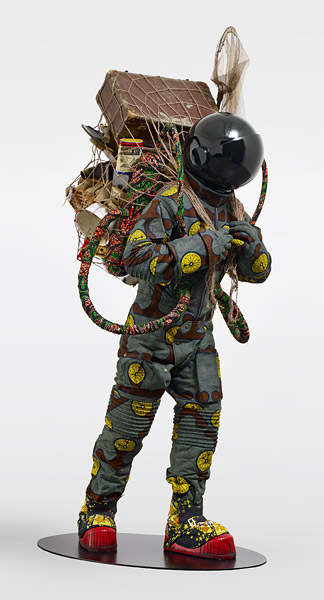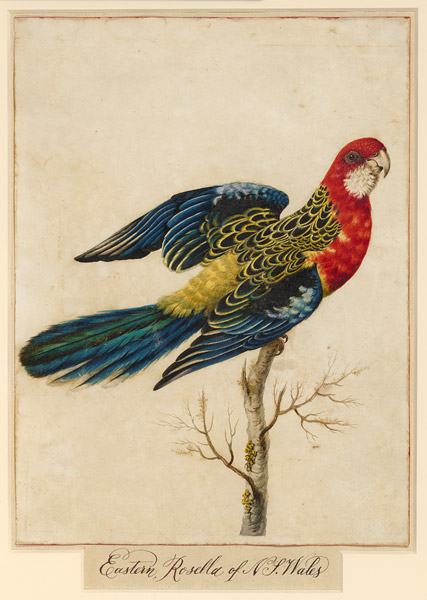Collections
Recent acquisition highlights
Recent acquisitions | Archived acquisitions
Acquisitions policy | Vision and policies
The National Gallery of Australia is continuously adding to the national collection, keeping abreast of emerging art as well as expanding existing collections.

Paul Cézanne Mountainous landscape near Aix c 1895
Paul Cézanne’s art was one of the foundations of modernism, with particular influence on Henri Matisse, Pablo Picasso and other Cubists. Despite his significance as an artist, however, Cézanne has a relatively small representation in public institutions in Australia, and opportunities to acquire his art are limited. Mountain landscape near Aix is, then, a very generous gift for all Australians to enjoy. Read more

Yinka Shonibare Refugee astronaut 2015
A traveller in an unknown world, the Refugee astronaut seems both under- and over-prepared for his trip. From the spherical helmet, spacesuit and moon boots, we might imagine him about to embark on an intergalactic journey. But the jumble of possessions and the makeshift nature of his backpack suggest another story. On closer inspection, the objects he carries, the fabric of his clothing and several other signs point to a compelling reading for our times. Read more

Jan Nelson Marion 2 2010 from the series Walking in tall grass
In an interview for the exhibition In the flesh, Jan Nelson described the title of her series Walking in tall grass as an analogy for the vulnerability and defiance of adolescence: ‘you can’t go back, you can only go forward, but you can’t see where you’re going’. This recent work, together with Shelby 2 2011, from Nelson’s ongoing study of young people have joined the NGA’s earlier examples from the series, Carter 2001 and Tim 2003. Read more

Tom Roberts Louis Abrahams 1886
In this portrait of his good friend, the painter and etcher Louis Abrahams, Roberts located his subject in a setting typical of the aesthetic of the time, with a screen, Asian cane chair and Turkish rug. On a shelf, behind the sitter, are a few small oil sketches, presumably painted en plein air by Abrahams, and a green umbrella, for outdoor painting. Read more
Janina Green The bridge and the willow 2002–03
Melbourne photomedia artist Janina Green has for over three decades produced handcoloured photographs that explore the possibilities and implications of applying colour to photographic prints. The Gallery has recently acquired Green's series The bridge and the willow, which brings together two of the artist's handcoloured photographs, taken from her archive and rephotographed, and fragments from late nineteenth-century handcoloured Japanese photographs. The Japanese images come from an album of Meiji-period (1868–1912) handcoloured albumen prints in Green's personal collection (an album originally purchased by Mr and Mrs McLeod in Japan in 1889). Read more
Paddy Fordham Wainburranga, Rembarrnga people Too many Captain Cooks 1988
If ever there was an Arnhem Land bark painter who developed his own innovative and distinct style it was the late Paddy Fordham Wainburranga. His bold illustrations of the Rembarrnga ancestors on twenty-four of the two hundred hollow log coffins that make up the The Aboriginal Memorial 1988 stand in direct stylistic contrast to the others. His depictions of impressive Balangjarngalain spirit figures appear to be caught in a tortured state of metamorphosis; they are elongated figurative forms frozen in time, regurgitating, twitching and recoiling erratically, full of foreboding spiritual power and energy. Read more
Sarah Stone Eastern rosella of New South Wales c 1790
When the first bird specimens from Australia arrived in England, they ruffled the feathers of the scientific establishment. Sarah Stone's Eastern Rosella of New South Wales is a rare watercolour of one such bird. This superb rendering of Platycercus eximius (or Nonpareil parrot, as it was then named) conveys Stone's astute understanding of the scholarly purpose of natural history illustrations. In depicting the rosella in profile and of natural size, perched on a branch with wings partially raised, the viewer is able to discern the wingspan, as well as the idiosyncratic colouring of the species' cheek patches and scalloped feathers. Read more




